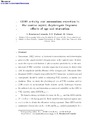Please use this identifier to cite or link to this item:
https://accedacris.ulpgc.es/jspui/handle/10553/7222
| DC Field | Value | Language |
|---|---|---|
| dc.contributor.author | Fernández-Urruzola, Igor | en_US |
| dc.contributor.author | Packard, Theodore T | en_US |
| dc.contributor.author | Gómez, May | en_US |
| dc.contributor.other | Gomez, May | - |
| dc.contributor.other | Packard, Theodore | - |
| dc.contributor.other | Fernandez-Urruzola, Igor | - |
| dc.date.accessioned | 2012-04-10T08:45:55Z | - |
| dc.date.accessioned | 2018-02-21T14:16:58Z | - |
| dc.date.available | 2012-04-10T08:45:55Z | - |
| dc.date.available | 2018-02-21T14:16:58Z | - |
| dc.date.issued | 2011 | en_US |
| dc.identifier.issn | 0022-0981 | en_US |
| dc.identifier.uri | https://accedacris.ulpgc.es/handle/10553/7222 | - |
| dc.description.abstract | Ammonium (NH4+) release by bacterial remineralization and heterotrophic grazers determines the regenerated fraction of phytoplankton productivity, so the measurement of NH4+ excretion in marine organisms is necessary to characterize both the magnitude and the efficiency of the nitrogen cycle. Glutamate dehydrogenase (GDH) is largely responsible for NH4+ formation in crustaceans and consequently should be useful in estimating NH4+ excretion by marine zooplankton.<br />Here, we address body size and starvation as sources of variability on the GDH to NH4+ excretion ratio (GDH/RNH4+). We found a strong correlation between the RNH4+ and the GDH activity (r2 = 0.87, n = 41) during growth. Since GDH activity maintained a linear relation (b = 0.93) and RNH4+ scaled exponentially (b =0.55) in well fed mysids, the GDH/RNH4+ ratio increased with size. However, the magnitude of its variation increased even more when adult mysids were starved. In this case, the GDH/RNH4+ ratio ranged from 11.23 to 102.41. | en_US |
| dc.language | eng | en_US |
| dc.relation.ispartof | Journal of Experimental Marine Biology and Ecology | en_US |
| dc.source | Journal of Experimental Marine Biology and Ecology [ISSN 0022-0981], v. 409 (1-2), p. 21-29 | en_US |
| dc.subject | 251001 Oceanografía biológica | en_US |
| dc.subject.other | Glutamate dehydrogenase | en_US |
| dc.subject.other | Ammonium excretion | en_US |
| dc.subject.other | Leptomysis lingvura | en_US |
| dc.subject.other | Starvation | en_US |
| dc.subject.other | Body size | en_US |
| dc.title | GDH activity and ammonium excretion in the marine mysid, "Leptomysis lingvura": effects of age and starvation | en_US |
| dc.type | info:eu-repo/semantics/Article | en_US |
| dc.type | Article | es |
| dc.type | Article | es |
| dc.identifier.doi | 10.1016/j.jembe.2011.07.035 | |
| dc.identifier.scopus | 82555167024 | |
| dc.identifier.scopus | 82555167024 | - |
| dc.identifier.scopus | 653710 | - |
| dc.identifier.scopus | -;-;1492 | - |
| dc.identifier.isi | 000298363100003 | - |
| dcterms.isPartOf | Journal Of Experimental Marine Biology And Ecology | - |
| dcterms.source | Journal Of Experimental Marine Biology And Ecology[ISSN 0022-0981],v. 409 (1-2), p. 21-29 | - |
| dc.contributor.authorscopusid | 48461211200 | - |
| dc.contributor.authorscopusid | 7004249480 | - |
| dc.contributor.authorscopusid | 7401734371 | - |
| dc.identifier.absysnet | 653710 | - |
| dc.identifier.crisid | -;-;1492 | - |
| dc.description.lastpage | 29 | - |
| dc.description.firstpage | 21 | - |
| dc.relation.volume | 409 | - |
| dc.investigacion | Ciencias | en_US |
| dc.rights.accessrights | info:eu-repo/semantics/openAccess | - |
| dc.type2 | Artículo | en_US |
| dc.identifier.wos | WOS:000298363100003 | - |
| dc.contributor.daisngid | 26127011 | - |
| dc.contributor.daisngid | 4236772 | |
| dc.contributor.daisngid | 311411 | - |
| dc.contributor.daisngid | 1273639 | - |
| dc.identifier.investigatorRID | L-9561-2014 | - |
| dc.identifier.investigatorRID | No ID | - |
| dc.identifier.investigatorRID | No ID | - |
| dc.contributor.wosstandard | WOS:Ferriandez-Urruzola, I | |
| dc.contributor.wosstandard | WOS:Packard, TT | |
| dc.contributor.wosstandard | WOS:Gomez, M | |
| dc.date.coverdate | Diciembre 2011 | |
| dc.identifier.ulpgc | Sí | es |
| dc.description.sjr | 1,067 | |
| dc.description.jcr | 1,875 | |
| dc.description.sjrq | Q1 | |
| dc.description.jcrq | Q2 | |
| dc.description.scie | SCIE | |
| item.fulltext | Con texto completo | - |
| item.grantfulltext | open | - |
| crisitem.author.dept | GIR ECOAQUA: Ecofisiología de Organismos Marinos | - |
| crisitem.author.dept | IU de Investigación en Acuicultura Sostenible y Ec | - |
| crisitem.author.dept | GIR ECOAQUA: Ecofisiología de Organismos Marinos | - |
| crisitem.author.dept | IU de Investigación en Acuicultura Sostenible y Ec | - |
| crisitem.author.dept | Departamento de Biología | - |
| crisitem.author.orcid | 0000-0001-7287-3503 | - |
| crisitem.author.orcid | 0000-0002-5880-1199 | - |
| crisitem.author.orcid | 0000-0002-7396-6493 | - |
| crisitem.author.parentorg | IU de Investigación en Acuicultura Sostenible y Ec | - |
| crisitem.author.parentorg | IU de Investigación en Acuicultura Sostenible y Ec | - |
| crisitem.author.fullName | Fernández Urruzola, Igor | - |
| crisitem.author.fullName | Packard, Theodore Train | - |
| crisitem.author.fullName | Gómez Cabrera, María Milagrosa | - |
| Appears in Collections: | Artículos | |
SCOPUSTM
Citations
17
checked on Jun 8, 2025
WEB OF SCIENCETM
Citations
12
checked on Jun 8, 2025
Page view(s)
67
checked on Dec 9, 2023
Download(s)
177
checked on Dec 9, 2023
Google ScholarTM
Check
Altmetric
Share
Export metadata
This item is licensed under a Creative Commons License

